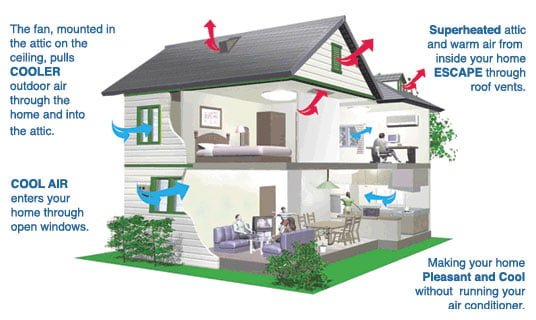I have to say that my experience with whole-house fans has not always been positive. I remember almost 20 years ago, my wife and I went to dinner at a friend’s house near Detroit. The living room was getting warm even though it was cool outside, so our friend said he was going to turn on the whole-house fan instead of the air conditioner. No sooner did he flip the switch than it sounded like a helicopter had landed on the roof. Papers blew everywhere, and our previously calm, quiet conversation turned into a shouting match, just so we could hear each other above the din.
At that point, I would have been horrified if an HVAC contractor suggested putting one of those beasts in our house. But times have changed, and now I strongly recommend them. The new style of ducted whole house fan designs are smarter, and thankfully much quieter. The problem is that many HVAC contractors just don’t offer these types of products to their customers.
SIMPLE CONCEPT
A whole-house fan is a fairly simple device. The fan is mounted in the ceiling of a central hallway (in the top floor of a two-story house) and draws cool outside air in through open doors and windows while forcing the hottest indoor air out the existing intake and exhaust vents on the roof. This cycle creates a comfortable living environment and reduces the air conditioning load for the next day.
A whole-house fan is effective whenever the outside temperature is lower than the indoor temperature, which is usually in the evenings and at night. It typically uses a fraction of the energy of air conditioning, which means drastically lower energy bills for the typical residence.
In dry desert climates, a whole-house fan is a no-brainer, as it can minimize or nearly eliminate the need for air conditioning completely. What many people don’t realize, however, is that even in most other areas of the United States, you can use it in conjunction with your a/c to significantly reduce your energy consumption.”
Several years ago a study was done on whole-house fans in Florida, and the conclusion was that, while they can increase humidity, fans reduce the temperature in a home. The study involved 384 single-family homes, apartments, and condos, and it showed that by using natural ventilation instead of air conditioning, 777 kWh was saved. So if you can use a fan, it does reduce the air conditioning costs wherever you are.
Obviously, the warmer and more humid the evening air, the less effective natural cooling becomes; however, whole-house fans are often used successfully to complement air conditioning systems. Most fan manufacturers like CentricAir state that as long as the outside temperature is below 72°F, a whole-house fan can effectively cool a home.
NEW DESIGNS, EASIER INSTALLATION
The traditional whole-house fan is fairly large and noisier than small fans, but can move between 4,000 and 7,000 cfm of air. This type of fan is installed in the ceiling, and louvers open when the fan is turned on. Newer whole house fan designs are available that have a flow range between 1,000 and 4,000 cfm.
The real distinction between the two is if people want to feel a breeze moving through the house, then they need to get the bigger fans. If they want to cool the house down slowly over a longer period of time, then the smaller fans work great. They’re quieter and more energy efficient, but they won’t create the kind of breeze that a 7,000-cfm fan will.
Besides being significantly quieter, some new whole house fans have motorized, insulated, sealed damper doors; no framing is required during installation; and a smaller fan running all night long will use much less energy compared to air conditioning. In addition, the house will be cooler in the morning.
The one major requirement for a whole-house fan is that the home has to have an attic with a certain amount of clearance, noted Paul Scelsi, training and communications manager, Air Vent, Dallas. “The installation instructions of the various models and brands make that clear.”
In addition, a home must have a sufficient amount of attic ventilation in order to exhaust the air. If there is not enough ventilating, the resulting positive pressure will force hot, dusty attic air back into the house through light fixtures and other cracks.
CHANGING MARKET
So if a whole-house fan saves energy, improves IAQ, offers a quick payback to customers, and increases a homeowner’s comfort level, why aren’t more HVAC contractors offering these products to customers? It’s difficult to say. Perhaps it’s an issue of education – both the contractor’s and the homeowner’s – or maybe it’s price, as the new whole house fans are substantially more expensive than the traditional models. What is known is that the other trades are making money installing whole-house fans in residential applications.
Right now, it’s the electricians who are usually putting in the whole-house fans. It would be a very profitable service for heating and cooling contractors to offer, because they’re already in a house and the fans can help make any air conditioning system work better.
And all contractors know that any type of differentiation from the competition is a good thing.
Sidebar: Attic Fans?
There’s a big difference between a whole-house fan and an attic fan. Attic fans are designed to ventilate the attic space only, while whole-house fans are designed to ventilate the living space within a home.
The Home Ventilating Institute (www.hvi.org) refers to whole-house fans as whole-house comfort ventilators, and they are designed to bring in cooler outside air, draw it through the house, and push the house air out through the attic vents.




